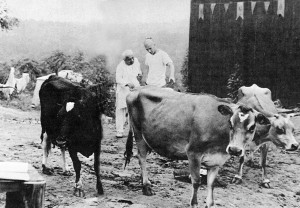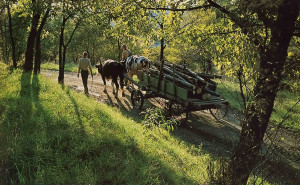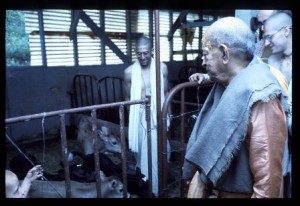Written by Madhava Smullen. Archival Research by Chaitanya Mangala.
There’s no doubt that protecting cows was very close to Srila Prabhupada’s heart.
In a series of Back to Godhead magazine articles in the mid 1950s, he was already envisioning a community where residents lived a simple life and protected cows.
Soon after registering ISKCON in New York in 1966, he began requesting his disciples to start a rural community, asking them to call it “ISKCON-Nagari or New Vrindaban.”
And when Hayagriva Das, Kirtananda Swami and a handful of other devotees began New Vrindaban, ISKCON’s first farm, in 1968 in the hills of West Virginia, he urged them to keep cows and bulls there, and to maintain them comfortably throughout their natural lives as their proverbial mothers and fathers.
The cow’s milk could be used to create all kinds of staple foods, and their dung dried and used as fuel, he explained. Bulls could pull plows to till the ground for food grains. Together, they offered the chance of a peaceful, self-sufficient life free from the modern world’s stressful rat race and favorable for advancing in Krishna consciousness.
What’s more, he explained to Hayagriva in one of his first letters about New Vrindaban’s development, caring for cows was what Lord Krishna did every morning in Goloka Vrindavana. “Krishna by His practical example taught us to give all protection to the cows, and that should be the main business of New Vrindaban,” he said.
Prabhupada continued to write the New Vrindaban devotees nearly every month, espousing the benefits of cow protection along with outright entreaties for action.
“I am anxiously awaiting receipt of your first cow,” he wrote to Shyama Dasi in March 1969. And in April: “I hope you will soon be getting a cow for New Vrindaban. Vrindaban without cows does not look well, so we must have many cows as soon as possible.”
 http://www.brijabasispirit.com/wp-content/uploads/2016/01/Kaliya-the-Cow-New-Vrindaban-BTG-photo-1971-768x531.jpg 768w, http://www.brijabasispirit.com/wp-content/uploads/2016/01/Kaliya-the-Cow-New-Vrindaban-BTG-photo-1971-500x346.jpg 500w, http://www.brijabasispirit.com/wp-content/uploads/2016/01/Kaliya-the-Cow-New-Vrindaban-BTG-photo-1971.jpg 1250w" sizes="(max-width: 300px) 100vw, 300px" class="align-center" />
http://www.brijabasispirit.com/wp-content/uploads/2016/01/Kaliya-the-Cow-New-Vrindaban-BTG-photo-1971-768x531.jpg 768w, http://www.brijabasispirit.com/wp-content/uploads/2016/01/Kaliya-the-Cow-New-Vrindaban-BTG-photo-1971-500x346.jpg 500w, http://www.brijabasispirit.com/wp-content/uploads/2016/01/Kaliya-the-Cow-New-Vrindaban-BTG-photo-1971.jpg 1250w" sizes="(max-width: 300px) 100vw, 300px" class="align-center" />
Kaliya the Cow New Vrindaban 1971
Devotees were glad to have finally purchased their first cow by the time Srila Prabhupada first visited New Vrindaban in May 1969. A black Jersey with a white mark on her forehead where Vaishnavas wear their tilak, she was named Kaliya, or “black,” by Prabhupada himself.
One of the first things the “Brijabasis” did when Prabhupada arrived was offer him a seat beneath a willow tree, and bring him fresh milk from Kaliya. They then sat around him in a semi-circle on the grass, looking up at him expectantly as he raised the cup to his lips.
Prabhupada was delighted. “I haven’t tasted milk like this in fifty years,” he said.
Excited at pleasing their spiritual master, the devotees brought Kaliya to meet him. Ranadhir Das paraded her before him, and Prabhupada admired her. “We don’t have such fatty cows in India,” he said. “In days past, yes, but now no one can feed them nicely. That is the way the Vedas calculate a man’s wealth—in cows and grains.” He even walked out to the barn to watch Ranadhir put Kaliya back in her stall.
During his visit, which lasted a whole month, Prabhupada continued encouraging the devotees, meeting with community leaders to discuss growing their herd from one to fifty. One cow’s milk could be shared by at least ten people, he said; or if each resident had their own cow, they could sell excess milk products and “get other necessities of life in that way.”
New Vrindaban and Kaliya stayed on Prabhupada’s mind after his visit. “I am always thinking of your New Vrindaban,” he wrote from Los Angeles just two days after leaving. “The first thing I find is the taste of the milk. The milk which we are taking here is not at all comparable with New Vrindaban milk.” He even offered to help finance more cows for the community.
Over the next few months and years, Prabhupada greatly enjoyed receiving in the mail curd cheese and milk sweets made from dairy provided by New Vrindaban’s protected cows; and he guided devotees in how to prepare them. “The whole idea of New Vrindaban is that men who are living there should produce their own food, of which milk is the principal thing,” he wrote.
After visiting New Vrindaban again in September 1972 to deliver a series of Bhagavat Dharma discourses, he was clearly enlivened by the progress he had seen. “I can see that Krishna is giving you more and more facility for developing this New Vrindaban scheme,” he said. “So this is very nice. I am very pleased that you have acquired some more cows.”
But he also cautioned the devotees not to forget about the bulls. “The cow is so wonderful and valuable in society,” he wrote. “But you should also use the bulls by engaging them in tilling the ground. People may call this the primitive way but it is very practical for engaging the bulls.”
 http://www.brijabasispirit.com/wp-content/uploads/2016/01/New-Vrindaban-1975-Summer-Ox-Team-768x474.jpg 768w, http://www.brijabasispirit.com/wp-content/uploads/2016/01/New-Vrindaban-1975-Summer-Ox-Team-500x308.jpg 500w" sizes="(max-width: 300px) 100vw, 300px" class="align-center" />
http://www.brijabasispirit.com/wp-content/uploads/2016/01/New-Vrindaban-1975-Summer-Ox-Team-768x474.jpg 768w, http://www.brijabasispirit.com/wp-content/uploads/2016/01/New-Vrindaban-1975-Summer-Ox-Team-500x308.jpg 500w" sizes="(max-width: 300px) 100vw, 300px" class="align-center" />
Bulls 1976
By the time Prabhupada visited New Vrindaban again in July 1974, its cow protection program was thriving. There were 100 cows spread across three farms – Bahulaban, Vrindaban and Madhuban – including sixteen milking cows who produced over 600 gallons of milk per week. A fourth farm, Nandagram, housed young oxen, and three ox teams were being trained.
Prabhupada visited the Bahulaban barn, walking down its length and closely observing the cows on either side. He stopped at Shukla, whose milk he had also drank, and patted her on the head. He then observed the cow Satyabhama being milked, and when told that she was giving nine gallons daily said to cowherd Devakinandana Das, “You are doing wonderfully here.”
After his visit, Prabhupada wrote that he was “very happy” while in New Vrindaban and enjoyed the atmosphere, “especially the cow protection scheme.”
He continued to encourage the devotees to build a farm community that would set an example for how to treat cows: “Let other farms see… how we derive benefit from them and that will be the living example to persons who are using cow flesh rather than cow milk.”
In 1976, when he visited New Vrindaban for the last time, the community was caring for four working teams of oxen and over 150 cows. A new barn had been erected in Bahulaban, and Prabhupada visited it to see the cows and four new-born calves. He let one of them lick his hand as a devotee told him how the cows were yielding about 120 gallons of milk every day, which they were turning into ghee, cheese and buttermilk. Prabhupada was pleased.
But there was one cow he still hadn’t seen. Kaliya, now fourteen years old, was the retired matriarch of New Vrindaban’s herd. She had given birth to eight calves herself, and up until the previous year, had still been producing about six gallons of milk a day for the Lord and the devotees – despite having maladies common to aging cows of her breed, such as blindness in one eye and respiratory problems.
Writing in Brijbasi Spirit magazine, cowherd Amburish Das described how Kaliya – the smallest cow in New Vrindaban at 800 pounds – never pushed and shoved to eat grain as the other cows did, but stood patiently waiting her turn. “There may be some mild cows, but Mother Kaliya is even more than mild – she is a devotee,” he said. “Her humility is unmatched.”
 http://www.brijabasispirit.com/wp-content/uploads/2016/01/Prabhupada-views-calves-in-New-Vrindaban-Amburish-1976.jpg 448w" sizes="(max-width: 300px) 100vw, 300px" class="align-center" />
http://www.brijabasispirit.com/wp-content/uploads/2016/01/Prabhupada-views-calves-in-New-Vrindaban-Amburish-1976.jpg 448w" sizes="(max-width: 300px) 100vw, 300px" class="align-center" />
Prabhupada Views Calves in New Vrindaban 1976
This rare soul was finally reunited with Srila Prabhupada after seven years in a meeting that left an indelible mark in the minds and hearts of those who witnessed it.
Towards the end of his visit, Prabhupada walked with a large group of devotees to go see Sri Sri Radha Vrindaban Nath in the farmhouse temple at the old Vrindaban farm, where Kaliya resided. It was a beautiful morning, the rays of the rising sun shining hazily through a light mist.
As Prabhupada rounded a curve and spotted the Vrindaban farmhouse in the distance, one of the devotees, Advaitacarya Das, pointed to a small herd of cows far up at the top of “Govardhana Hill,” which rose to their left. “Srila Prabhupada, look!” he said. “There’s Kaliya. She’s our first cow. You used to drink her milk.”
Suddenly, as Prabhupada looked up at her, Kaliya broke away from her herd and made her way alone down the steep bank. Matching the devotees’ pace, she stepped out right in front of Srila Prabhupada, and began walking with him as if she were his pet calf.
“Ah,” Srila Prabhupada said simply. “My dear old friend Kaliya.”
She continued to walk with him for some time, a quiet connection hanging between them that the devotees all felt. Then, finally Kaliya picked up her pace and disappeared over the horizon.
“For me, it was a mystical experience,” says Advaita. “Srila Prabhupada was always preaching that we’re all trying to get to Vrindavana, where Krishna and his cowherd boy friends are eternally playing and taking care of the cows. And to see Kaliya come down the hill and walk with him like that just made it all very real.”
After this last visit to New Vrindaban, Prabhupada continued to encourage his followers to establish cow protection programs all over the world. And to all of them, he gave New Vrindaban as the model farm community to emulate – the home of Kaliya, the “Queen of New Vrindaban,” and ISKCON’s very first cow.
Information and Links
Join the fray by commenting, tracking what others have to say, or linking to it from your blog.
Comments